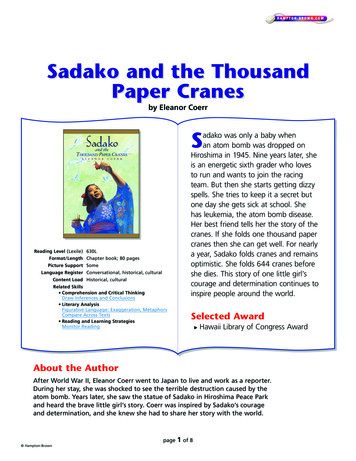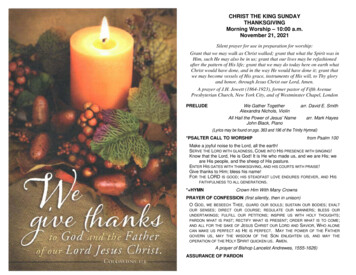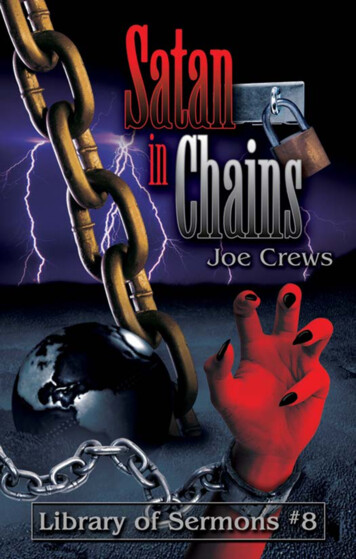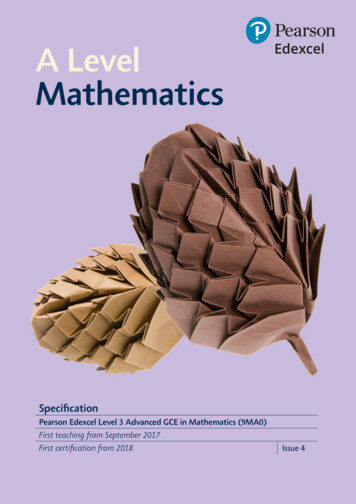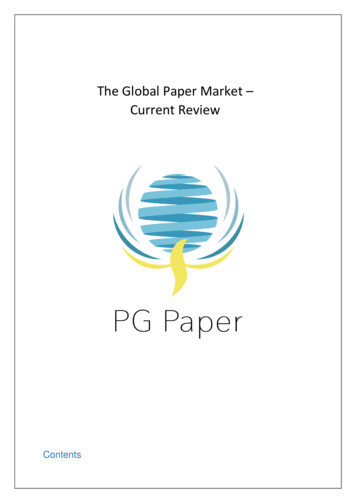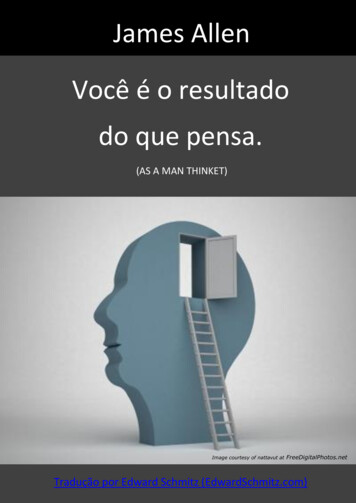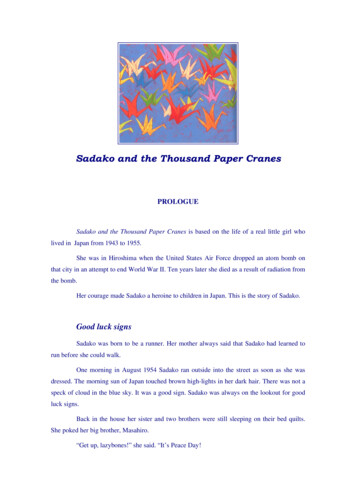
Transcription
Sadako and the Thousand Paper CranesPROLOGUESadako and the Thousand Paper Cranes is based on the life of a real little girl wholived in Japan from 1943 to 1955.She was in Hiroshima when the United States Air Force dropped an atom bomb onthat city in an attempt to end World War II. Ten years later she died as a result of radiation fromthe bomb.Her courage made Sadako a heroine to children in Japan. This is the story of Sadako.Good luck signsSadako was born to be a runner. Her mother always said that Sadako had learned torun before she could walk.One morning in August 1954 Sadako ran outside into the street as soon as she wasdressed. The morning sun of Japan touched brown high-lights in her dark hair. There was not aspeck of cloud in the blue sky. It was a good sign. Sadako was always on the lookout for goodluck signs.Back in the house her sister and two brothers were still sleeping on their bed quilts.She poked her big brother, Masahiro.“Get up, lazybones!” she said. “It’s Peace Day!
Masahiro groaned and yawned. He wanted to sleep as long as possible, but like mostfourteen- year-old boys, he also loved to eat. When he sniffed the good smell of bean soup,Masahiro got up. Soon Mitsue and Eiji were awake, too.Sadako helped Eiji get dressed. He was six, but he sometimes lost a sock or shirt.Afterward, Sadako folded the bed quilts. Her sister, Mitsue, who was nine, helped put themaway in the closet.Rushing like a whirlwind into the kitchen, Sadako cried, “Oh, Mother! I can hardlywait to go to the carnival. Can we please hurry with breakfast?”Her mother was busily slicing pickled radishes to serve with therice and soup. She looked sternly at Sadako. “You are eleven years old andshould know better,” she scolded. “You must not call it a carnival. Everyyear on August sixth we remember those who died when the atom bomb wasdropped on our city. It is a memorial day.Mr. Sasaki came in from the back porch. “That’s right,” he said.“Sadako chan, you must show respect. Your own grandmother was killed that awful day.”“But I do respect Oba chan,” Sadako said. “I pray for her spirit every morning. It’sjust that I’m so happy today.”“As a matter of fact, it’s time for our prayers now,” herfather said.The Sasaki family gathered around the little altar shelf.Oba chan’s picture was there in a gold frame. Sadako looked atthe ceiling and wondered if her grandmother’s spirit was floatingsomewhere above the altar.“Sadako chan!” Mr. Sasaki said sharply.Sadako quickly bowed her head. She fidgeted andwriggled her bare toes while Mr. Sasaki spoke. He prayed thatthe spirits of their ancestors were happy and peaceful. He gavethanks for his barbershop. He gave thanks for his fine children. And he prayed that his familywould be protected from the atom bomb disease called leukemia.Many still died from the disease, even though the atom bomb had been dropped onHiroshima nine years before. It had filled the air with radiation—a kind of poison—that stayedinside people for a long time.
At breakfast Sadako noisily gulped down her soup and rice. Masahiro began to talkabout girls who ate like hungry dragons. But Sadako didn’t hear his teasing. Her thoughts weredancing around the Peace Day of last year. She loved the crowds of people, the music, andfireworks. Sadako could still taste the spun cotton candy.She finished breakfast before anyone else. When she jumped up, Sadako almostknocked the table over. She was tall for her age and her long legs always seemed to get in theway.“Come on, Mitsue chan,” she said. “Let’s wash the dishes so that we can go soon.”When the kitchen was clean and tidy, Sadako tied red bows on her braids and stood impatientlyby the door.“Sadako chan,” her mother said softly, “we aren’t leaving until seven-thirty. You cansit quietly until it is time to go.”Sadako plopped down with a thud onto the tatami mat. Nothing ever made her parentshurry. While she sat there a fuzzy spider paced across the room. A spider was a good luck sign.Now Sadako was sure the day would be wonderful. She cupped the insect in her hands andcarefully set it free sdon’treallybringgoodluck.”“Just wait and see!” Sadako said gaily.Peace DayWhen the family started out, the air was already warm and dust hungover the busy streets. Sadako ran ahead to the house of her best friend,Chizuko. The two had been friends since kindergarten.Sadako was sure that they would always be as close as two pineneedles on the same twig.Chizuko waved and walked toward her. Sadako sighed. Sometimesshe wished that her friend would move a bit faster. “Don’t be such a turtle!”she shouted. “Let’s hurry so we won’t miss anything.”“Sadako chan, go slowly in this heat,” her mother called after her. But it was too late.The girls were already racing up the street.Mrs. Sasaki frowned. “Sadako is always in such a hurry to be first that she never stopsto listen,” she said.
Mr. Sasaki laughed and said, “Well, did you ever see her walk when she could run,hop, or jump” There was pride in his voice because Sadako was such a fast, strong runner.At the entrance to the Peace Park people filed through the memorial building in silence. On thewalls were photographs of the dead and dying in a ruined city. The atom bomb — theThunderbolt — had turned Hiroshima into a desert.Sadako didn’t want to look at the frightening pictures. She held tight to Chizuko’shand and walked quickly through the building.“I remember the Thunderbolt,” Sadako whispered to her friend. “There was the flashof a million suns. Then the heat prickled my eyes like needles.“How can you possibly remember anything?” Chizuko exclaimed. “You were only ababy then.”“Well, I do!” Sadako said stubbornly.After speeches by Buddhist priests and the mayor, hundreds of white doves were freedfrom their cages. They circled the twisted, scarred Atomic Dome. Sadako thought the doveslooked like spirits of the dead flying into the freedom of the sky.When the ceremonies were over, Sadako led the others straight to the old lady whosold cotton candy. It tasted even better than last year.The day passed too quickly, as it always did. The best part, Sadako thought, waslooking at all the things to buy and smelling the good food. There were stalls selling everythingfrom bean cakes to chirping crickets. The worst part was seeing people with ugly whitish scars.The atom bomb had burned them so badly that they no longer looked human. If any of the bombvictims came near Sadako, she turned away quickly.Excitement grew as the sun went down. When the last dazzling display of fireworksfaded from the sky, the crowd carried paper lanterns to the banks of the Ohta River.Mr. Sasaki carefully lit candles inside of six lanterns — one for each member of thefamily. The lanterns carried names of relatives who had died because of the Thunderbolt.Sadako had written Oba chan’s name on the side of her lantern. When the candles were burningbrightly, the lanterns were launched on the Ohta River. They floated out to sea like a swarm offireflies against the dark water.That night Sadako lay awake for a long time, remembering everything about the clay.Masahiro was wrong, she thought. The spider had brought good luck. Tomorrow she wouldremind him about that.
Sadako’s secretIt was the beginning of autumn when Sadako rushed home with the good news. Shekicked off her shoes and threw open the door with a bang. “I’m home!” she called.Her mother was fixing supper in the kitchen.“The most wonderful thing has happened!” Sadako saidbreathlessly. “Guess what!”“Many wonderful things happen to you, Sadako chan. Ican’t even guess.”“The big race on Field Day!” Sadako said. “I’ve beenchosen from the bamboo class to be on the relay team.” Shedanced around the room, gaily swinging her school bag. “Justthink. If we win, I’ll be sure to get on the team in junior highschool next year.” That was what Sadako wanted more thananything else.At supper Mr. Sasaki made a long speech about family honor and pride. EvenMasahiro was impressed. Sadako was too excited to eat. She just sat there, grinning happily.From then on Sadako thought of only one thing — the relay race. She practiced every day atschool and often ran all the way home. When Masahiro timed her with Mr. Sasaki’s big watch,Sadako’s speed surprised everyone. Maybe, she dreamed, I will be the best runner in the wholeschool.At last the big day arrived. A crowd of parents, relatives, and friends gathered at theschool to watch the sports events. Sadako was so nervous she was afraid her legs wouldn’t workat all. Members of the other team suddenly looked taller and stronger than her teammates.When Sadako told her mother how she felt, Mrs. Sasaki said, “Sadako chan, it is natural to be alittle bit afraid. But don’t worry. When you get out there, you will runas fast as you can.”Then it was time for the relay race.“Just do your best,” Mr. Sasaki said, giving Sadako’s handa squeeze. “We’ll be proud of you.The kind words from her parents made the knot in Sadako’sstomach loosen. They love me, no matter what, she thought.At the signal to start, Sadako forgot everything but the race.When it was her turn, she ran with all the strength she had. Sadaco’s
heart was still thumping painfully against her ribs when the race was over.It was then that she first felt strange and dizzy. She scarcely heard someone cry, “Yourteam won!” The bamboo class surrounded Sadako, cheering and shouting. She shook her head afew times and the dizziness went away.All winter Sadako tried to improve her running speed. To qualify for the racing teamin junior high she would have to practice every day. Sometimes after a long run the dizzinessreturned. Sadako decided not to tell her family about it.She tried to convince herself that it meant nothing, that the dizziness would go away.But it didn’t. It got worse. Frightened, Sadako carried the secret inside of her. She didn’t eventell Chizuko, her best friend.On New Year’s Eve Sadako hoped she could magically wish away the dizzy spells.How perfect everything would be if she didn’t have this secret! At midnight she was in her cozybed quilts when the temple bells began to chime. They were ringing out all the evils of the oldyear so that the new one would have a fine beginning. With each ring Sadako drowsily madeher special wish.The next morning the Sasaki family joined crowds of people as they visited theirshrines. Mrs. Sasaki looked beautiful in her best flowered silk kimono.“As soon as we can afford it, I’ll buy a kimono for you,” she promised Sadako. “A girlyour age should have one.”Sadako thanked her mother politely, but she didn’t care about a kimono. She onlycared about racing with the team in junior high.Amidst throngs of happy people Sadako forgot her secret for a while. She let thebright joy of the season wash her worries away. At the end of the day she raced Masahiro homeand won easily. Above the door were the good luck symbols Mrs. Sasaki had put there toprotect them during the new year.With a beginning like this, how could anything bad happen?A secret no longerFor several weeks it seemed that the prayers and good luck symbols had done theirwork well. Sadako felt strong and healthy as she ran longer and faster.
But all that ended one crisp, cold winter day inFebruary. Sadako was running in the school yard. Suddenlyeverything seemed to whirl around her and she sank to theground. One of the teachers rushed over to help.“I . . . I guess I’m just tired,” Sadako said in a weakvoice. When she tried to stand up, her legs went wobbly and shefell down again. The teacher sent Mitsue home to tell Mr. Sasaki.He left his barbershop and took Sadako to the Red CrossHospital. As they entered the building Sadako felt a pang of fear.Part of this hospital was especially for those with the atom bombsickness.In a few minutes Sadako was in an examining room where a nurse x-rayed her chestand took some of her blood. Dr. Numata tapped her back and asked a lot of questions. Threeother doctors came in to look at Sadako. One of them shook his head and gently stroked herhair.By now the rest of Sadako’s family was at the hospital. Her parents were in thedoctor’s office. Sadako could hear the murmur of their voices. Once her mother cried,“Leukemia! But that’s impossible!” At the sound of that frightening word Sadako put her handsover her ears. She didn’t want to hear anymore. Of course she didn’t have leukemia. Why, theatom bomb hadn’t even scratched her.Nurse Yasunaga took Sadako to one of the hospital rooms and gave her a kind ofcotton kimono to wear. Sadako had just climbed into bed when her family came in.Mrs. Sasaki put her arms around Sadako. “You must stay here for a little while,” shesaid, trying to sound cheerful. “But I’ll come every evening.”“And we’ll visit you after school,”Masahiro promised.Mitsue and Fiji nodded, their eyes wideand scared.“Do I really have the atom bombdisease?” Sadako asked her father.There was a troubled look in Mr. Sasaki’s eyes, but he only said, “The doctors want tomake some tests—that’s all.” He paused. Then he added, “They might keep you here for a fewweeks.”
A few weeks! To Sadako it sounded like years. She would miss graduation into juniorhigh school. And even worse, she would not be part of the racing team. Sadako swallowed hardand tried not to cry.Mrs. Sasaki fussed over Sadako. She plumped the pillows and smoothed thebedspread. Mr. Sasaki cleared his throat. “Is is there anything you want?” he asked.Sadako shook her head. All she really wanted was to go home, But when? A coldlump of fear grew in her stomach. She had heard that many people who went into this hospitalnever came out.Later Nurse Yasunaga sent the others away so that Sadako could rest. When she wasalone, Sadako buried her face in the pillow and cried for a long time. She had never before feltso lonely and miserable.The Golden CraneThe next morning Sadako woke up slowly. She listened for the familiar sounds of hermother making breakfast, but there were only the new and different sounds of a hospital.Sadako sighed. She had hoped that yesterday was just a bad dream. It was even morereal when Nurse Yasunaga came in to give her a shot.“Getting shots is part of being in the hospital,” the plump nurse said briskly. “You’llget used to it.”“I just want the sickness to be over with,” Sadako said unhappily, “so I can go home.”That afternoon Chizuko was Sadako’s first visitor. She smiled mysteriously as sheheld something behind her back. “Shut your eyes,” she said. While Sadako squinted her eyestightly shut, Chizuko put some pieces of paper and scissors on the bed. “Now you can look,”she said.“What is it?” Sadako asked, staring at the paper.Chizuko was pleased with herself. “I’ve figured out a way for you to get well,” shesaid proudly. “Watch!” She cut a piece of gold paper into a large square. Ina short time she had folded it over and over into a beautiful crane.Sadako was puzzled. “But how can that paper bird make mewell?”“Don’t you remember that old story about the crane?” Chizukoasked. “It’s supposed to live for a thousand years. If a sick person folds one
thousand paper cranes, the gods will grant her wish and make her healthy again.” She handedthe crane to Sadako. “Here’s your first one.”Sadako’s eyes filled with tears. How kind of Chizuko to bring a good luck charm!Especially when her friend didn’t really believe in such things. Sadako took the golden craneand made a wish. The funniest little feeling came over her when she touched the bird. It must bea good omen.“Thank you, Chizuko chan,” she whispered. “I’ll never never part with it.”When she began to work with the paper, Sadako discovered that folding a cranewasn’t as easy as it looked. With Chizuko’s help she learned how to do the difficult parts. Aftermaking ten birds, Sadako lined them up on the table beside the golden crane. Some were a bitlopsided, but it was a beginning.“Now I have only nine hundred and ninety to make,” Sadako said. With the goldencrane nearby she felt safe and lucky. Why, in a few weeks she would be able to finish thethousand. Then she would be strong enough to go home.That evening Masahiro brought Sadako’s homework from school. When he saw thecranes, he said, “There isn’t enough room on that small table to show off your birds. I’ll hangthem from the ceiling for you.”Sadako was smiling all over. “Do you promise to hangevery crane I make?” she asked.Masahiro promised.“That’s fine!” Sadako said, her eyes twinkling withmischief. “Then you’ll hang the whole thousand?”“A thousand!” Her brother groaned. “You’re joking!”Sadako told him the story of the cranes.Masahiro ran a hand through his straight black hair.“You tricked me!” he said with a grin. “But I’ll do it anyhow.”He borrowed some thread and tacks from Nurse Yasunaga and hung the first tencranes. The golden crane stayed in its place of honor on the table.After supper Mrs. Sasaki brought Mitsue and Eiji to the hospital. Everyone wassurprised to see the birds. They reminded Mrs. Sasaki of a famous old poem:Out of colored paper, cranes
come flying intoour house.Mitsue and Eiji liked the golden crane best. But Mrs. Sasaki chose the tiniest onemade of fancy green paper with pink parasols on it. “This is my choice,” she said, “becausesmall ones are the most difficult to make.”After visiting hours it was lonely in the hospital room. So lonely that Sadako foldedmore cranes to keep up her courage.Eleven. . . I wish I’d get better.Twelve . . . I wish I’d get better.KenjiEveryone saved paper for Sadako’s good luck cranes. Chizuko brought colored paperfrom the bamboo class. Father saved every scrap from the barbershop. Even Nurse Yasunagagave Sadako the wrappings from packages of medicine. And Masahiro hung every one of thebirds, as he had promised. Sometimes he strung many on one thread. The biggest cranes flewalone.During the next few months there were times when Sadako felt almost well. However,Dr. Numata said it was best for her to stay in the hospital. By now Sadako realized that she hadleukemia, but she also knew that some patients recovered from the disease. She never stoppedhoping that she would get well, too.On good days Sadako was busy. She did her homework, wrote letters to friends andpen pals, and amused her visitors with games, riddles, and songs. In the evening she alwaysmade paper cranes. Her flock grew to over three hundred. Now the birds were perfectly folded.Her fingers were sure and worked quickly without any mistakes.Gradually the atom bomb disease took away Sadako’s energy. She learned about pain.Sometimes throbbing headaches stopped her from reading and writing. At other times her bonesseemed to be on fire. And more dizzy spells sent Sadako into deep blackness. Often she was tooweak to do anything but sit by the window and look longingly out at the maple tree in thecourtyard. She would stay there for hours, holding the golden crane in her lap.Sadako was feeling especially tired one day when Nurse Yasunaga wheeled her outonto the porch for some sunshine. There Sadako saw Kenji for the first time. He was nine andsmall for his age. Sadako stared at his thin face and shining dark eyes.“Hello!” she said. “I’m Sadako.”
Kenji answered in a low, soft voice. Soon the two were talking like old friends. Kenjihad been in the hospital for a long time, but he had few visitors. His parents were dead and hehad been living with an aunt in a nearby town.“She’s so old that she comes to see me only once a week,” Kenji said. “I read most ofthe time.”Sadako turned away at the sad look on Kenji’s face.“It doesn’t really matter,” he went on with a weary sigh, “because I’ll die soon. I haveleukemia from the bomb.”“But you can’t have leukemia,” Sadako said quickly. “You weren’t even born then.”“That isn’t important,” Kenji said. “The poison was in my mother’s body and I got itfrom her.”Sadako wanted so much to comfort him, but she didn’t know what to say. Then sheremembered the cranes. “You can make paper cranes like I do,” she said, “so that a miracle canhappen.”“I know about the cranes,” Kenji replied quietly, “butit’s too late. Even the gods can’t help me now.”Just then Nurse Yasunaga came out onto the porch.“Kenji,” she said sternly, “how do you know such things?”He gave her a sharp look. “I just know,” he said.“And besides, I can read my blood count on the chart. Everyday it gets worse.”The nurse was flustered.“What a talker!” she said. “You are tiring yourself.”And she wheeled Kenji inside.Back in her room Sadako was thoughtful. She tried to imagine what it would be like tobe ill and have no family. Kenji was brave, that’s all. She made a big crane out of her prettiestpaper and sent it across the hall to his room. Perhaps it would bring him luck. Then she foldedmore birds for her flock.Three hundred and ninety-eight.Three hundred and ninety-nine.One day Kenji didn’t appear on the porch. Late that night Sadako heard the rumble ofa bed being rolled down the hall. Nurse Yasunaga came in to tell her that Kenji had died.
Sadako turned to the wall and let the tears come.After a while she felt the nurse’s gentle hand on her shoulder. “Let’s sit by thewindow and talk,” Nurse Yasunaga said in a kindly voice.When Sadako finally stopped sobbing, she looked out at the moonlit sky. “Do youthink Kenji is up there on a star island”“Wherever he is, I’m sure that he is happy now,” the nurse said. “He has shed thattired, sick body and his spirit is free.”Sadako was quiet, listening to the leaves on the maple tree rustle in the wind. Then shesaid, I m going to die next, aren’t I?”“Of course not!” Nurse Yasunaga answered with a firm shake of her head. She spreadsome colored paper on Sadako’s bed. “Come and let me see you fold another paper crane beforeyou go to sleep. After you finish one thousand birds, you’ll live to be an old, old lady.”Sadako tried hard to believe that. She carefully folded cranes and made the same wish.Four hundred and sixty-three.Four hundred and sixty-four.Hundreds of wishesJune came with its long, endless rains. Day after day the sky was gray as rain spatteredagainst the windows. Rain dripped steadily from the leaves of the maple tree. Soon everythingin the room smelled musty. Even the sheets felt clammy.Sadako grew pale and listless. Only her parents and Masahiro were allowed to visither. The bamboo class sent a Kokeshi doll to cheer her up. Sadako liked the wooden doll’swistful smile and the red roses painted on its kimono. The doll stood next to the golden crane onSadako’s bedside table.Mrs. Sasaki was worried because Sadako didn’t eat enough. One evening she broughta surprise wrapped in a furoshiki bundle. It contained all of Sadako’s favorite foods—an eggroll, chicken and rice, pickled plums, and bean cakes. Sadako propped herself up against thepillows and tried to eat. But it was no use. Her swollen gums hurt so much that she couldn’tchew. Finally, Sadako pushed the good things away. Her mother’s eyes were bright as if shewere going to cry.
“I’m such a turtle!” Sadako burst out. She was angry with herself for making hermother sad. She also knew that the Sasaki family had no extra money for expensive food. Tearsstung Sadako’s eyes and she quickly brushed them away.“It’s all right,” Mrs. Sasaki said soothingly. She cradled Sadako in her arms. “You’llbe better soon. Maybe when the sun comes out again ”Sadako leaned against her mother and listened to her read from a book of poems.When Masahiro came, Sadako was calmer and happier. He told her news from school and atesome of the special dinner.Before Masahiro left, he said, “Oh, I almost forgot! Eiji sent you a present.” He duginto his pocket and pulled out a crumpled piece of silver paper. “Here,” he said, giving it to hissister. “Eiji said this is for another crane.”Sadako sniffed the paper. “Ummm! It smells like candy,” she said. “I hope the godslike chocolate.”The three burst out laughing. It was the first time Sadako had laughed in days. It was agood sign. Perhaps the golden crane’s magic was beginning to work. She smoothed out thepaper and folded a bird.Five hundred and forty-one But she was too tired to make more. Sadako stretched out on the bed and closed hereyes. As Mrs. Sasaki tiptoed out of the room, she whispered a poem she used to say whenSadako was little:“O flock of heavenly cranesCover my child with your wings.”Last DaysNear the end of July it was warm and sunny. Sadako seemed to be getting better. “I’mover halfway to one thousand cranes,” she told Masahiro, “so something good is going tohappen.”And it did. Her appetite came back and much of the pain went away. Dr. Numata waspleased with her progress and told Sadako she could go home for a visit. That night Sadako wasso excited she couldn’t sleep. To keep the magic working she made more cranes.Six hundred and twenty-one.Six hundred and twenty-two.
It was wonderful to be home with the family for 0 Bon,the biggest holiday of the year. 0 Bon was a special celebrationfor spirits of the dead who returned to visit those they had lovedon earth.Mrs. Sasaki and Mitsue had scrubbed and swept thehouse until it shone. Fresh flowers brightened the table. Sadako’sgolden crane and Kokeski doll were there, too. The air was filledwith smells of delicious holiday food. Dishes of bean cakes andrice balls had been placed on the altar shelf for ghostly visitors.That night Sadako watched her mother put a lanternoutside so that the spirits could find their way in the dark. She letout a happy sigh. Perhaps, just perhaps, she was home to stay.For several days a steady stream of friends and relatives come to call on the Sasakifamily. By the end of a week Sadako was pale and tired again. She could only sit quietly andwatch the others.“Sadako certainly has good manners now,” Mr. Sasaki said. “Oba chan’s spirit mustbe pleased to see how ladylike her granddaughter has become.“How can you say that!” Mrs. Sasaki cried. “I would rather have our lively Sadakoback.” She dabbed at her eyes and hurried into the kitchen.I’m making everyone sad, Sadako thought. She wished she could suddenly turn intoher old self. How happy her mother would be then!As if he knew what was in Sadako’s mind, her father said gruffly, “There now, don’tworry. After a good night’s rest you’ll feel fine.”But the next day Sadako had to return to the hospital. For the first time she was glad tobe in the quiet hospital room. Her parents sat beside the bed for a long time. Every now and thenSadako drifted off into a strange kind of halfsleep.“When I die,” she said dreamily, “will you put my favorite bean cakes on the altar formy spirit?”Mrs. Sasaki could not speak. She took her daughter’s hand and held it tightly.“Hush!” Mr. Sasaki said in a funny voice. “That will not happen for many, many years. Don’tgive up now, Sadako chan. You have to make only a few hundred more cranes.”Nurse Yasunaga gave Sadako medicine that helped her rest. Before her eyes closed,Sadako reached out to touch the golden crane.
“I will get better,” she murmured to the Kokeslii doll, “and someday I’ll race like thewind.”From then on Dr. Numata gave Sadako blood transfusions or shots almost every day.“I know it hurts,” he said, “but we must keep on trying.”Sadako nodded. She never complained about the shots and almost constant pain. Abigger pain was growing deep inside of her. It was the fear of dying. She had to fight it as wellas the disease. The golden crane helped. It reminded Sadako that there was always hope.Mrs. Sasaki spent more and more time at the hospital. Every afternoon Sadako listened for thefamiliar slap-slap of her plastic slippers in the hail. All visitors had to put on yellow slippers atthe door, but Mrs. Sasaki’s made a special sound. Sadako’s heart ached to see her mother’s faceso lined with worry.The leaves on the maple tree were turning rust and gold when the family came for onelast visit. Eiji handed Sadako a big box wrapped in gold paper and tied with a red ribbon.Slowly Sadako opened it. Inside was something her mother had always wanted for her—a silkkimono with cherry blossoms on it. Sadako felt hot tears blur her eyes.“Why did you do it?” she asked, touching the soft cloth. “I’ll never be able to wear itand silk costs so much money.”“Sadako chan,” her father said gently, “your mother stayed up late last night to finishsewing it. Try it on for her.”With a great effort Sadako lifted herself out of bed. Mrs. Sasaki helped her put on thekimono and tie the sash. Sadako was glad her swollen legs didn’t show. Unsteadily she limpedacross the room and sat in her chair by the window. Everyone agreed that she was like aprincess in the kimono.At that moment Chizuko came in. Dr. Numata had given her permission to visit for ashort time. She stared at Sadako in surprise. “You look better in that outfit than in schoolclothes,” she said.Everyone laughed. Even Sadako. “Then I’ll wear it to classes every day when I’m wellagain,” she joked.Mitsue and Eiji giggled at the idea.For a little while it was almost like the good times they used to have at home. Theyplayed word games and sang Sadako’s favorite songs. Meanwhile, she sat stiffly in the chair,trying not to show the pain it caused her. But it was worth the pain. When her parents left, theylooked almost cheerful.
Before she went to sleep, Sadako managed to fold only one paper crane.Six hundred and forty-four.It was the last one she ever made.Racing with the windAs Sadako grew weaker, she thought more about death. Would she live on a heavenlymountain? Did it hurt to die? Or was it like falling asleep?If only I could forget about it, Sadako thought. But it was like trying to stop the rainfrom falling. As soon as she concentrated on something else, death crept back into her mind.Toward the middle of October, Sadako lost track of days and nights. Once, when she wasawake, she saw her mother crying.“Don’t cry,” she begged. “Please don’t cry.” Sadako wanted to say more, but hermou
From then on Sadako thought of only one thing — the relay race. She practiced every day at school and often ran all the way home. When Masahiro timed her with Mr. Sasaki’s big watch, Sadako’s speed surprised everyone. Maybe, she dreamed, I will be the best
